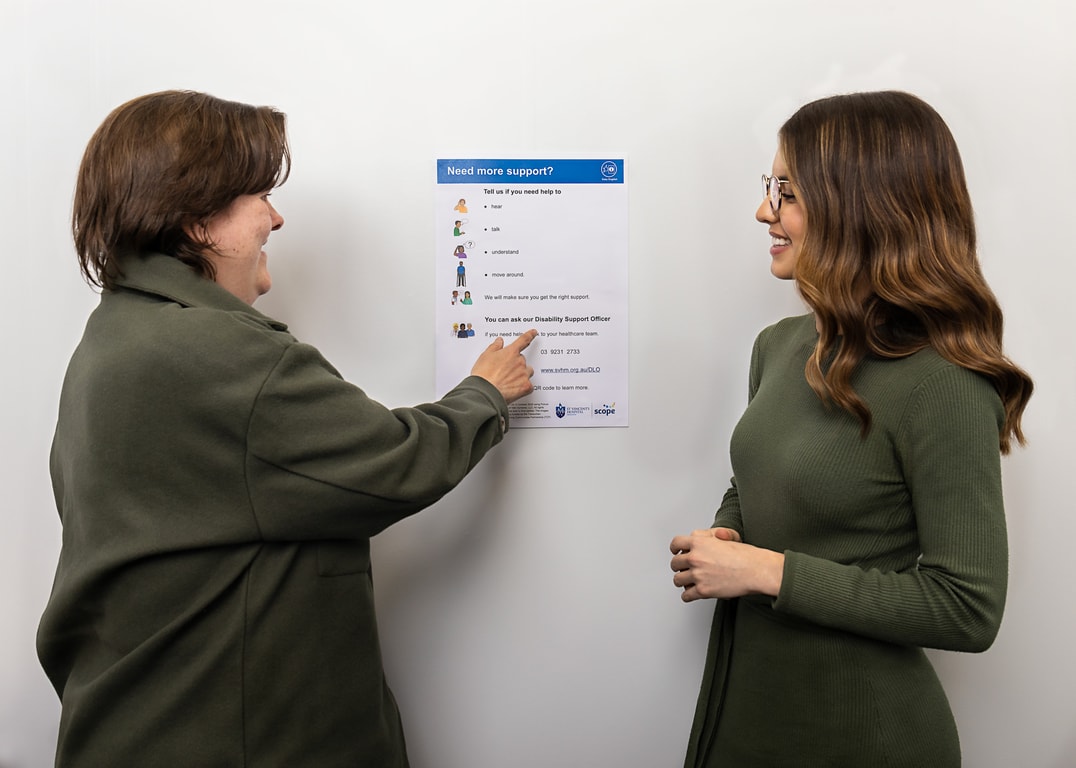Can I ask you to wear your face mask?
Scope developed a new Easy English brochure for St Vincent's Hospital to help patients with disability understand their rights


Interaction occurs whenever you and the child do things together and respond to one another.
Every time you and your child interact, you make the connection that gets the communication started. Many children with Autism find interaction difficult and may be ‘cut-off’ socially, or only know how to engage with others for a limited number of communicative purposes. Through play, children realise new reasons to interact with others. Children learn to be aware of others and enjoy their company. Friendships, parent-child bonds, and other relationships develop through play.
Learning occurs when children feel secure and comfortable, play is one of these times of optimal learning. Children can connect during play, this means having fun together, wanting to be with someone and experiencing the joy of communicating with another. Here are some top tips for facilitating effective playtime with a child with Autism.
1. Have a shared language
A shared method of communication and language can be speech, Key Word Sign, or symbols such as line drawings on electronic or non-electronic devices. This shared language allows us to share our messages together successfully.
Play is the perfect place for children’s self-expression. Children want to tell stories, comment on things that are funny, protest at what they don’t like, ask for new things or a repetition of something they have enjoyed. If talking is hard for a child, we can show them other methods, so they can keep growing, even when words are difficult.
Look at how your child communicates, she may cry or scream, she might move her body next to people and things she is interested in, or turn her body away, or she may use gestures or facial expressions. Look for and respond to your child’s non-verbal communication (eye contact, movement, breathing, touch, facial expression and posture) using a communication method that she can learn and use too. For example, a child might play with her doll house. Have a communication board at hand with words such as night-night, eat, yum, more, go, shopping, uh-oh!
2. Keep play relaxed and stress free
Keep play in a routine: repetitive and predictable. Children may need their play time structured similarly to other daily routines. Too many new things and changes ca n make learning harder.
Using an aided language display with words for the activity on it is a great way to keep you in the routine and using consistent language.
3. Go at your child’s pace
Children with Autism need communication to be geared at an appropriate level for them. Allow your child to make choices about toys and games you will use during play time together. You may use a choice board with images on it to help them learn language at the same time. Respond to what your child is focused on and her interests, for example, if she is pushing a car, try doing the same thing. Children are often easier to engage and may want to stay in the interaction if we follow their lead.
Children with Autism need no more than a few toys at a time. They may be distracted by a lot of detail or sensory stimulation. Imitation of the child’s actions is a simple way to engage with them. Your goal is establishing a connection, so look at the same thing together and practice sharing the toys.
4. Focus on the interaction
Children with Autism often need your help to develop early interaction skills such as engaging with and attending to an adult, taking turns, and imitating. Insist on joining in on what your child is doing, even if she doesn’t welcome you at first. You might want to use “turn” cards, or “break cards” to help create the routine and predictability.
Use toys or games where your child needs to interact with you for the game to work. The things your child likes might be hard for you to understand, she may enjoy playing in different ways, which others need to understand and value. Children with Autism need adults to value motivating “toys” even if they don’t seem like a toy to us, for example ripping paper, or a game of running the same route around the house. The goal is to engage with her in her play, whatever that looks like.
5. Be fun!
We need to be fun to engage children. Being fun is how we create communication opportunities. In play, children have the freedom to try things in a non-pressured way. There is no right or wrong. It’s a space for you to be over-the-top animated and interesting during interactions. This will get your child’s attention and maintain her engagement with you. Think on your feet and don’t be afraid to try things out.
When you have followed your child’ lead often you can then develop the interaction by adding in new things. Make yourself interesting and use your facial expression, noise, volume, pitch of your voice, AND use Key Word sign and natural gestures. When you find things she responds to, add them into the routine.
You can find great Key Word Sign nursery rhymes!